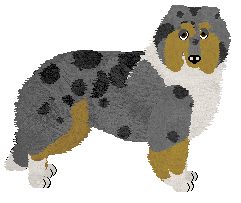Tan: Blue merle (strict) with


 markings in the traditional pattern or minimal creeping pattern.
markings in the traditional pattern or minimal creeping pattern. White Markings: Must have white in the irish spotting pattern. Piebald, extreme white or solid white all over is also allowed but faulted.
Sable:
Sable: Red sable is accepted in any of the patterns.
 is also an accepted base colour. A widow's peak is preferred.
is also an accepted base colour. A widow's peak is preferred.Merle: Sable merle (strict).
White Markings: Must have white in the irish spotting pattern. Piebald, extreme white or solid white all over is also allowed but faulted.
Tricolour:
Tan:
 with
with 

 markings in the traditional pattern or minimal creeping pattern.
markings in the traditional pattern or minimal creeping pattern.White Markings: Must have white in the irish spotting pattern. Piebald, extreme white or solid white all over is also allowed but faulted.
 - Blue merles may have one or two
- Blue merles may have one or two  , all others must have brown.
, all others must have brown.







